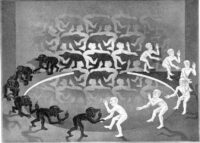The ability to concentrate our attention and focus precisely upon an object or a thought requires filtering and mediating our experience of the world. Our five senses afford us the ability to detect information only within a limited range. Our eyes perceive certain wavelengths in the visible spectrum, just as our ears detect limited frequencies of sound waves. Taste and smell are defined by the capabilities of tongue and nose, while touch varies from highly sensitive to somewhat dull. Sensory abilities vary person to person, but they generally fall within a predictable range.
Other animals perceive the world quite differently, of course. Bees see a world of ultraviolet light, dogs follow the most modest scent for miles, whales communicate across oceans, elephants use their feet to feel low frequency vibrations produced by other elephants, and birds and insects utilize magnetic fields to navigate.
Within our physiological limitations, we humans must nonetheless filter our experience of the world, lest we become overwhelmed and over-stimulated. Autism has been described by some as a set of mental/physiological reactions due to the inability of the mind to filter the flood of sensory stimulation that constantly comes our way. Despite the illusion of “multitasking,” we cannot actually do many things at once; rather, multitasking is simply a rapid shift of concentration from one object or moment to another.
Some experiences, like driving a car, allow us to enter into a peculiar concentrative state in which broad awareness of the environment is required, as opposed to a highly narrowed, tightly filtered focus. Driving is an activity during which our perception must be tight enough to quickly detect events needing attention, but not so tight that we lose our ability to detect happenings at the edges of perception. Moreover, we respond quickly and without thinking, relying almost entirely on sensory perception to safely operate a vehicle. Sometimes called “naked attention,” we have this talent because our senses naturally evolved within the world as it is, and we are comfortably familiar with its physical laws.
Yet, we exist in an infinite universe of interpenetrating realms of existence, including multiple visible and invisible forces, fields, dimensions, organic and inorganic objects. From the miniscule neutrino to the enormity of a galactic cluster, we exist alongside myriad known and unknown realms which interact seamlessly and simultaneously in dramatic or subtle ways.
For those of you who have driven a car and know first-hand the type of concentration I’ve described, I would like to suggest a little experiment. Find yourself a comfortable chair, and as if you were behind the wheel of a car, sit upright and alert. Become sensitive to what is immediately around you, and let your awareness of light, color, sound, temperature and movement grow. Stay loose, but not too loose, and see if you can do this without getting distracted. Be focused, but also be aware of the panoramic edges of your perception. Hold that state of concentration for a minute, and then let it gently fall away.
We generally view time as a continuously moving chronological stream which carries all objects and discrete events within it. However, it’s also possible to perceive a timeless totality – the non-obstructed, interpenetrating, simultaneous, constantly new and fresh emergence of everything at each moment. And all this, moreover, while we ourselves simultaneously arise, arise, arise.
We welcome your feedback. For general feedback or to contact one of our columnists, please visit the Columns page at www.sonomasun.com.




